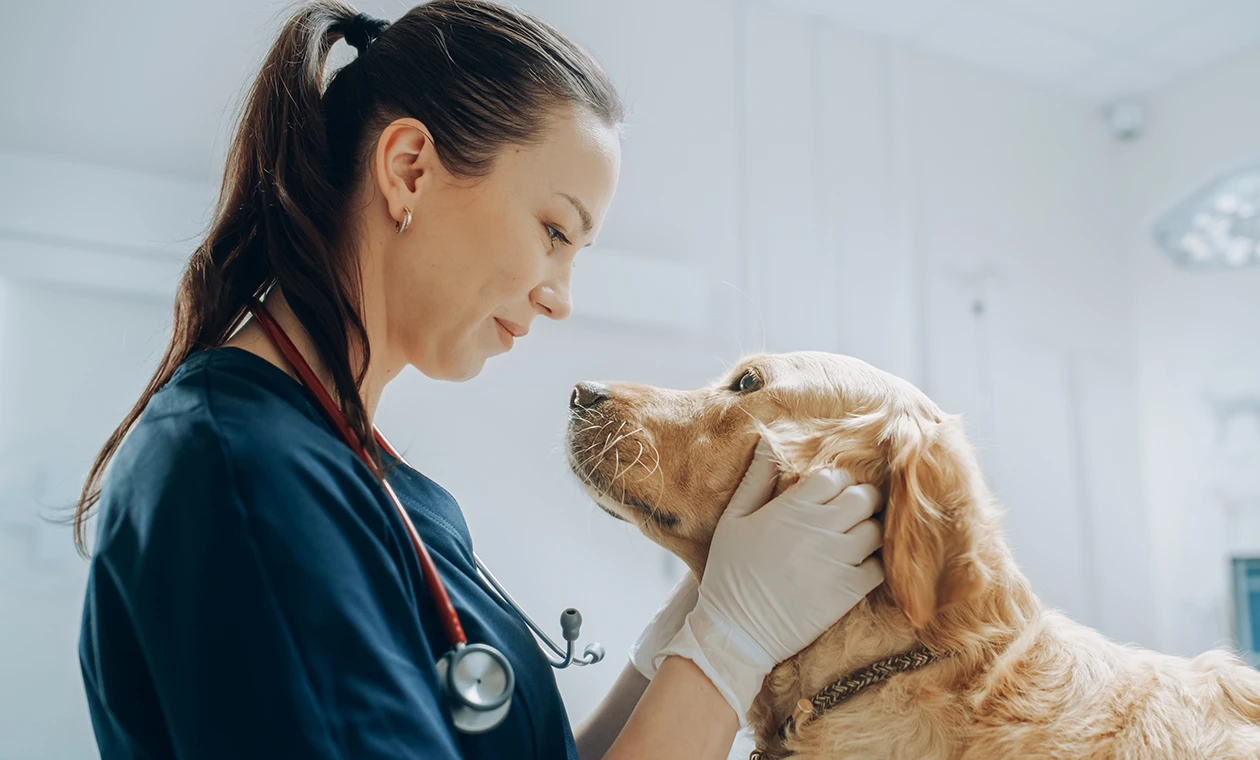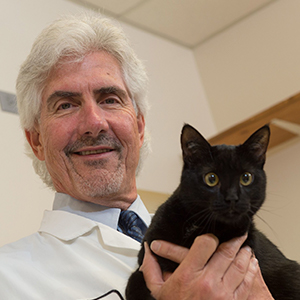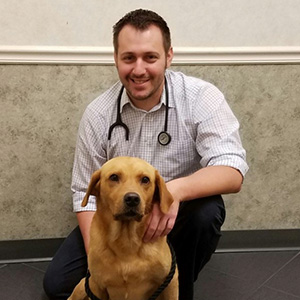

With the number of social media and online review platforms ever-growing, it’s hard to keep up with it all—let alone know if your practice even needs to. We’ll review the platforms out there, their pros and cons, and what it takes to keep them up. Learn workflows and hacks to determine what’s right for your team and clientele.
Artificial intelligence (AI) and tools like ChatGPT are transforming the way many small businesses and marketers alike approach marketing. In this lecture, we will explore the pros and cons of using AI in vet med marketing and practical ways that veterinary clinics can leverage AI and tools like ChatGPT to create more personalized and efficient marketing campaigns.
Running a veterinary practice (or any small business) is HARD. But there are tools out there to make your business run more efficiently and effectively– many of them from outside the veterinary industry. From team communication to SOP creation to digital forms to marketing and more, there truly is “an app for that.” Dive into an overview on tried-and-true-in-a-practice techy tools that just might help you save some time, while learning tips on how to choose, how to implement, and how to NOT get overwhelmed by new technology.
This lecture delves into the nuances of managing both in-house and online pharmacies, and offers practical strategies for effective marketing through social media, website, and email to ensure pet owners find convenience, pets find compliance, and veterinary teams find efficiency (and revenue). We’ll cover the latest data in customer preferences, techy solutions like QR codes and Jotforms to streamline refill processes and new ideas to enhance client engagement and action.
Effective communication is essential for veterinary practices to maintain a healthy client base and ensure pets receive optimal care. One of the most valuable communication tools in a practice’s arsenal is the reminder system. In this lecture, we will explore the marketing potential of reminders and how they can be leveraged to facilitate preferred client behaviors. By optimizing reminders, practices can set expectations ahead of time, educate clients about necessary services, and streamline online booking and refill requests, saving time and energy for the team. Discover the potential of reminders as a marketing tool and how to use them to enhance client engagement and loyalty.
Online reviews are a dreaded topic among many veterinary professionals, but yet are widely expected and trusted by our clientele. Learn strategies to know if and when to respond, to proactively build your library of five star reviews, to use existing reviews to convert more clients, and finally, concrete examples on best practices and resources for dealing with negative reviews and positive reviews alike.
With more social media channels and often less staff and time, it can be hard to know what to post and where to keep your practice’s social media and online presence healthy and effective. Make sure the posts you’re making are worth your time and energy and help facilitate your practice’s goals– whether that’s client education, differentiation from the competition, driving business or client behaviors.

Dirofilaria immitis is an extremely common and often life-threatening parasitic infection, with ≈ 1million dogs testing positive annually in the U.S. While the condition is common, there are still many misperceptions concerning the life cycle and transmission of this mosquito-vectored disease. Additionally, numerous questions still arise concerning the accuracy of diagnostic procedures, and resistance to the preventatives and proper adulticidal therapy. This presentation will attempt to provide insights into our changing understanding of heartworm infections in dogs and the opportunities that exist to provide better protection for our pet companions.
Control of tick infestations and tick transmitted diseases can be difficult and frustrating. Reports of product failures are common and resistance are often blamed. However, various biologic and ecologic factors are actually responsible for most perceived control failures. One area of specific importance is the documented range expansion and increased density of several important tick species and associated tick-borne diseases. This lecture will highlight the host, habitat and climatic factors that have contributed to changes in tick distribution, density and seasonality. Information will also be presented on how changes in tick range and density have contributed to spread of tick transmitted diseases. Current data on tick product performance and implementing effective tick control strategies will also be discussed.
This seminar will highlight several of the important advances in our understanding of flea biology that have had direct impacts on development of control programs, including the parasite-host relationship of C. felis, differences in male and female develop times, the critical concept of premises biomass and host acquisition. In addition, major changes in product development and implementation of flea control programs occurred following advances in our understanding of the residual speed of kill and reproductive break-points of insecticides. Data generated in in-home investigations have repeated demonstrated that the systemic isoxazolines can effective eradicate flea infestations and provide rapid reduction in pruritus and improvement in clinical signs of Flea Allergy Dermatitis (FAD).
Ancylostoma caninum is a common and pathogenic hookworm species of dogs that has been historically easy to manage with a wide array of anthelmintics. However, in recent years there have been a number of reports of anthelmintic treatment failures. These cases were at first confined primarily to retired racing greyhounds, but more recently have been documented in more than 20 dog breeds. Multi-Anthelmintic Drug Resistance (MADR) is now well documented and new diagnostic approaches and treatment options are being developed. This seminar will detail the current state of knowledge on MADR in Ancylostoma caninum and provide an update on potential treatments
While giardiasis is common it certainly is not routine. Questions concerning what is the best diagnostic test and the most effective treatment persist. Issues concerning zoonotic potential and public health implications are difficult to ascertain. This seminar will provide an update on the diagnosis, control and zoonotic potential of giardiasis in dogs and cats.

This presentation will cover normal, abnormal and unusual dental conditions found on dental radiographs in both dogs and cats.
This presentation will cover normal, abnormal and unusual dental conditions found on dental radiographs in both dogs and cats.

With the limited availability of specialty and emergency clinics, practitioners are often seeing routine same day cases with a variety of more critical cases mixed in. This lecture will take practitioners through busy day in our ER talking about all the ways the walk-in service can bring many surprises.
Practices offering same day service are going to see trauma. This lecture will review the systematic evaluation of trauma in small animals with an emphasis toward triage, stabilization and timing of primary therapy. I give case examples for upper airway trauma, penetrating chest wounds, pulmonary contusions, broken backs, head trauma, myocardial contusions, and urinary bladder rupture.
A video/case-based discussion covering the emergency approach to the dyspneic pet. We will cover common causes of dyspnea in cats (bronchial asthma, pulmonary edema, and pleural effusion) and dogs (laryngeal paralysis pneumonia, bronchitis, pneumonia and pulmonary edema).
This lecture reviews all the types of catheters we employ in emergency and critical care medicine. We show cephalic, lateral saphenous, medial saphenous, jugular and intraosseous techniques. For each technique I will give some case examples, discuss the benefits and risks of each. Each will be show using video clips to clarify the techniques.
This lecture takes practitioners through a logical workup for all trauma patients. I stress evaluation of the Airway, Breathing, Cardiovascular system, and neurologic trauma. I give case examples for upper airway trauma, penetrating chest wounds, pulmonary contusions, broken backs, head trauma, myocardial contusions, and urinary bladder rupture. I have video clips for each case.
Recognizing the importance of the veterinary technician in postoperative nursing of the critical patient, this lecture uses several cases (Gastric dilatation volvulus, and pelvic fracture patient) to discuss the monitoring devoted to these patients. We stress monitoring and optimizing the following: Respiratory function, fluid balance, cardiac function, renal function, neurologic function, gastrointestinal function, clotting/bleeding, blood pressure, patient comfort, sedation and pain control.
Using case examples and video, I discuss the management of renal failure stressing closed collection catheterization, monitoring, and fluid planning. I use an example of ethylene glycol poisoning to introduce peritoneal dialysis. I also discuss managing urinary tract obstructions in dogs and cats, pyometra, prostatic abscess, and dystocia.

Thoracic radiographic studies are likely the most common site imaged in veterinary medicine. The radiographic appearance of lung disease can be challenging in our feline patients. A discussion and overview of the lung patterns with case examples will be presented. Computed tomography is more sensitive for the detection of pulmonary disease so a few case examples will be incorporated into this presentation.
Radiographic interpretation of cardiovascular disease in cats, in and out of heart failure will be reviewed. Thoracic radiographic clues of systemic hypertension will be included. Echocardiographic scanning tips will be provided to improve your ability to get a diagnostic scan. The pros and cons of a focused cardiac ultrasound vs a complete echocardiogram will be discussed. The goal is to make you feel more comfortable interpreting radiographic and echocardiographic findings in cats suspected of underlying cardiac disease.

Positioning for Success: Getting diagnostic canine and feline thoracic, abdominal and orthopedic radiographs with radiographic technique critique.
Bloody Good Time- Canine and feline blood transfusions, blood typing, and patient monitoring.
Staying Alive- Canine and Feline Basic and Advanced CPR- chest compressions, breaths per minute, emergency drugs and team communication.

Extractions are the most common surgery performed in general practice and are a frequent source of frustration. Come and review the steps of extractions, learn hints for improving efficiency and how to manage common complications.
Cats have some unique features of oral disease that are important to understand when managing their oral healthy. This lecture will highlight features of tooth resorption, unique features of feline periodontal disease and feline chronic gingivostomatitis.
For many patients, oral tumors are incidental findings identified by veterinarians during conscious or anesthetized oral exams. This lecture will focus on a practical approach after identification of tumors within the oral cavity. More than 60% of oral tumors identified in the dog will be benign, though some of these tumors will demonstrate very locally aggressive behavior. In cats, more than 70% of tumors of the oral cavity are malignant. Early identification is critical for successful treatment. Once identified, oral tumors should be imaged and biopsied. Early intervention is critical for definitive treatment in cases of oral malignancy. Clear and understandable communication with owners is also important during the identification and diagnosis of an oral tumor.
Oral diseases are seen most commonly in older pets. However, there are a number of significant oral disease, including inflammatory disease, malocclusions and injuries that are more commonly identified in young animals. This hour will focus on diagnosis and management of oral disease in young dogs and cats.

This lecture covers tips for performing a good orthopedic exam on cats. It also discusses the most common orthopedic injuries seen in cats. The lecture includes the medical management of osteoarthritis and a discussion of sedation for performing the exam when needed. Practitioners will learn tips for performing a comprehensive orthopedic exam in cats, develop rule-out lists for exam findings, learn about various feline orthopedic conditions, and differentiate orthopedic and neurological findings in cats.
This session discusses the diagnosis and non-surgical management of feline osteoarthritis. Multimodal management and other treatment options will be discussed. Surgical management is only briefly discussed. This session is for all small animal practitioners who see arthritic cats in their practice. Practitioners will learn about the differences between the presentation of arthritis in dogs and cats, the principles of pain management for arthritic cats, and multimodal management.
This lecture discusses the principles of PT and rehab for feline patients. This includes a discussion of the special challenges presented when working with cats requiring physical therapy. Exercises and follow-up guidelines are included for patients following common orthopedic injuries and surgeries. Practitioners will learn in-hospital rehab techniques and principles for more formal rehab. They will also learn about conditions requiring formal rehab vs. those that can be done as outpatients in primary care practices.

In this lecture, Dr. Lappin will review the data supporting use of probiotics or synbiotics in the management of diarrhea in dogs and cats. Emphasis will be placed on use of products with excellent quality control and published papers. How the speaker uses hydrolysed, high fiber, and elemental diets in the management of his chronic enteropathy cases will also be presented.
In this lecture, Dr. Lappin will review the data supporting use of probiotics or synbiotics in the management of diarrhea in dogs and cats. Emphasis will be placed on use of products with excellent quality control and published papers. How the speaker uses hydrolysed, high fiber, and elemental diets in the management of his chronic enteropathy cases will also be presented.
In this lecture, Dr. Lappin with discuss current concepts in the management of radiodense bladder stones and feline interstitial cystitis. Emphasis will be placed on dietary management. Ways to management stress in cats without the use of drugs will also be covered.
In this lecture, Dr. Lappin with discuss current concepts in the management of radiodense bladder stones and feline interstitial cystitis. Emphasis will be placed on dietary management. Ways to management stress in cats without the use of drugs will also be covered.
Feline URI continues to be a major problem for cats around the world. In this lecture, Dr. Lappin with discuss the ISCAID antibiotic guidelines for use with bacterial causes and discuss how best to keep the chronic viral causes in remission, including the use of immune modulating probiotics.
Feline URI continues to be a major problem for cats around the world. In this lecture, Dr. Lappin with discuss the ISCAID antibiotic guidelines for use with bacterial causes and discuss how best to keep the chronic viral causes in remission, including the use of immune modulating probiotics.

We all see itchy kitties in practice. In this session, we will examine how we can help our itchy feline friends, focusing especially on feline allergic skin disease. We will delve into what’s new in feline allergy with an emphasis on diagnosis and therapeutic modalities. Cases will also be presented.
We all see itchy kitties in practice. In this session, we will examine how we can help our itchy feline friends, focusing especially on feline allergic skin disease. We will delve into what’s new in feline allergy with an emphasis on diagnosis and therapeutic modalities. Cases will also be presented.
In this session, we will discuss various tips and therapies that I use to help my derm patients and that you will be able to use to help your patients as well
Exciting clinical updates for the general practitioner from recent veterinary dermatology conferences and publications.

Common ophthalmic surgery techniques will be discussed. Clinical cases will be presented to demonstrate tips for successful outcomes and how to handle complications.
The diagnosis and treatment of age related eye diseases in dogs will be presented. Normal age related changes will be also be discussed.
The top ocular emergencies in dogs and cats will be presented with case examples. Diagnosis and treatment plans will be discussed.
Primary and secondary glaucoma cases in dogs and cats will be presented. Tonometry for diagnosis including helpful tips for use in practice and glaucoma medications and treatment plans will be discussed.

In this session, we will review the types of disc disease that can affect dogs and the clinical signs which result. We will outline the diagnostic work and the treatment options available based upon the severity of the clinical signs.
In this session we will discuss a step by step treatment protocol for emergency seizures in dogs and cats. We will outline what to do if the seizures don’t stop when treated in a standard manner.
The practical evaluation of the head trauma patient is important to both determine the best therapeutic approach and the prognosis. In this session we will discuss what aspects of the neurological exam are important in head trauma patients, what diagnostics to consider and what they mean prior to choosing how to treat on an emergency basis.
In this session, we will talk about the practical evaluation of the spinal trauma patient in order to determine the best therapeutic approach and the prognosis. We will discuss treatment options and when there is a conservative option vs. a surgical need.
The drugs available, the side effects and how to use them will be discussed for the management of dogs with difficult to control seizures. Adjunctive alternative approaches will also be discussed.
Neuromuscular disease is a common problem in dogs and less frequent in cats. We will discuss how these cases clinically present, how we can evaluate them and what diseases to consider when they present on an acute basis vs. chronic basis. Although myasthenia should always be considered there are multiple peripheral nerve and muscle causes of this type of weakness that we will talk about, in addition to neuromuscular junction problems which include tick paralysis, botulism and snake bite.

For dental radiography technique we will discuss the importance and proper positioning of dental radiographs in cats and dogs.
For dental probing and charting we will discuss how to properly probe and chart along with discussion of dental blocks and their importance.
For fear free feline venipuncture we will discuss ways to properly restrain feline with and without chemical restraint to obtain blood collection.

Anesthesia for pediatric patients will discuss the unique concerns for these patients in the cardiovascular and respiratory systems and their ability to metabolize drugs. We will discuss the potential adverse effects of hypothermia, hypoglycemia and hypotension. This discussion will include case examples.
Anesthesia for geriatric patients will discuss the age-related changes that can affect anesthesia and how this may affect our protocol. This discussion will include case examples.
Breed specific anesthesia protocols will discuss the particular anesthesia concerns certain breeds of dogs and cats may have as related to respiratory, cardiovascular and metabolic conditions.
Anesthesia/sedation for the difficult or anxious patient will discuss how to safely manage those animals that are not easily handled. This discussion will include drugs that the owner may give prior to the veterinary visit to ease the animals stress and then what can the veterinary staff do when the animal arrives.
Anesthesia new drug updates will discuss the newer agents on the market and how and why to implement them into your practice.

At the end of this presentation, participants/attendees should be able to…
• …define, describe, and provide examples of zoonotic canine parasites.
• …demonstrate good comprehension of common zoonotic canine parasites, roundworms, hookworms, tapeworms, fleas and ticks.
• …describe areas where zoonotic canine parasites are most common (both at national scale and local scale) and places at greatest risk for introduction of these parasites.
• …describe environmental factors that support the presence of zoonotic canine parasites in the U.S.
• …describe best practices for diagnosing zoonotic canine parasites and their treatment.
• …provide recommendations and guidance to dog owners on strategies to reduce the risk of zoonotic canine parasites for dogs.
• …discuss how good parasite control practices for dogs benefits human health as relates to these parasitic infections.
At the end of this presentation, participants/attendees should be able to…
• …demonstrate good comprehension of where lone star ticks exist in the U.S.
• …describe environmental factors that support lone star tick populations in the U.S.
• …demonstrate good comprehension of when (e.g. season, temperature) lone star ticks are likely to be present in the environment.
• …describe regions of the U.S. where dogs and humans are at greatest risk for lone star tick associated tick-borne pathogens and diseases.
• …discuss tick-borne pathogens and diseases associated with lone star ticks that pose a health risk to dogs and humans in the U.S.
• …discuss why tick speed of kill is important to support canine health and reduce the risk of tick-borne diseases.
• …demonstrate an ability to offer suggestions to clients on tick control and prevention measure for pets and people.
At the end of this presentation, participants/attendees should be able to…
• …discuss the risk that ticks pose to animal and human health.
• …describe environmental, societal, and other factors that influence the changing geographic distribution of tick species and their associated pathogens that pose risk to companion animal health.
• …demonstrate good comprehension of tick species, including recently introduced Haemphysalis longicornis (Asian longhorned tick), that threaten U.S. companion animal health.
• … demonstrate good comprehension of where to locate resources for reviewing or reporting information on contemporary and regionally-pertinent tick and tick-borne pathogen distribution and prevalence
• …describe tick control strategies for companion animals.

Feline allergies can be frustrating for both the veterinary clinician and the owner. Effective client communication is a key factor in having an improved rate of success. This lecture will focus on what we know about allergies in cats, including clinical signs and the lack of effective treatment options when compared to their canine counterparts. Focus will be made on communicating the issues to the concerned per owner.
Bacterial infections, especially those resistant to multiple classes of antimicrobials, are a constant burden on the veterinary clinician. It is becoming more and more challenging to manage these infections which are often secondary to underlying issues. This lecture will cover the pathogenesis, diagnosis, and treatment of bacterial infections in veterinary patients. Special focus will be dedicated to how bacterial infections can complicate other, underlying disease states.
Bacterial infections, especially those resistant to multiple classes of antimicrobials, are a constant burden on the veterinary clinician. It is becoming more and more challenging to manage these infections which are often secondary to underlying issues. This lecture will cover the pathogenesis, diagnosis, and treatment of bacterial infections in veterinary patients. Special focus will be dedicated to how bacterial infections can complicate other, underlying disease states.

Discuss various rodenticides encountered in veterinary medicine. The modes of action and treatment of toxicity of each in dogs and cats.
Underlying causes, emergency stabilization, treatment and management of urethral obstruction in male feline patients.

Cough is a common presenting complaint in older dogs with left-sided systolic murmur. The goal of this webinar is a help clinicians decide the origin of the cough (e.g., cardiac vs respiratory) in order to aid treatment decisions. A practical stepwise approach to these cases will be discussed, including answering important questions such as, 1) does the patient has clinically significant cardiomegaly, or 2) is the patient experiencing congestive heart failure due to cardiogenic pulmonary edema. The attendee will take away practical tips about case management, including if echocardiography is not an option.
This session will review the natural history and clinical stages of myxomatous mitral valve disease (MMVD) in dogs. This understanding will empower clinicians to make ideal treatment recommendations based on the 2019 expert consensus guidelines. New treatment recommendations published since the 2019 guidelines will be discussed including, whether ACE-inhibitor and spironolactone drugs are necessary, if cardiac diets are helpful, and if surgical or interventional options exists for some clients.
This session will focus on presenting cases of dogs with breathing difficulty secondary to cardiovascular disease. Clinical dilemmas of differentiating dogs with heart failure and pulmonary hypertension and managing concurrent arrhythmias and heart failure will be discussed. Case examples will be used to help illustrate how to manage these difficult cases. Management principals of pulmonary hypertension, ventricular tachyarrhythmias, and atrial fibrillation will be discussed.

• Discuss principals of wound healing.
• Describe techniques to intervene in healing process in a helpful way.
• Review several available wound products and they can be incorporated into your practice.
• Explore several challenging wound cases.
• Apply the techniques discussed to given cases.
• Discuss principals of wound healing.
• Describe techniques to intervene in healing process in a helpful way.
• Review several available wound products and they can be incorporated into your practice.
• Explore several challenging wound cases.
• Apply the techniques discussed to given cases.
Total Hip Replacement – (1 hour):
• Discuss indications and contraindications for THR.
• Describe implants used in THR.
• Describe the preoperative and postoperative care for THR patients
• Understand the major concepts of total hip replacement surgery.

Allergies in cats are one of the most challenging and frustrating medical conditions we deal with as veterinarians. This largely is due to the severity of dermatological lesions, significantly decreased quality of life, limited medical therapy options, and difficultly administering medications to cats. Cats tend to develop significant psychogenic components to pruritic behaviors that need to be addressed to maintain adequate control of the clinical signs. This lecture will cover the common allergic reaction patterns in cats and how to differentiate allergy types in cats so that effective treatment plans can be implemented.
Hot spots and acral lick dermatoses occur commonly and are highly frustrating for pet owners and veterinarians. Hot spots, AKA acute moist dermatitis or pyotraumatic dermatitis, is an acute onset of well-demarcated exudative dermatitis characterized by severe excoriation, alopecia, erythema, intense pruritus, +/- pain, exudate, and excoriation. Acral lick dermatitis, AKA lick granuloma and acral pruritic nodule, is a more chronic lesion characterized by lichenified (thickened), firm, raised, alopecic (hairless) plaque located on the distal extremity caused by excessive licking. There are many causes of these lesions, and most are allergic in origin. These primary causes must be diagnosed and treated in order to achieve complete resolution of these clinical lesions. Perianal dermatitis describes inflammation of the tissue surrounding the anus. There are numerous causes of perianal dermatitis including allergic skin disease, gastrointestinal parasites, anal sacculitis, vulvar intertrigo, perianal fistulae, and neoplasia. Clinical signs consistent with perianal dermatitis include behaviors of discomfort such as licking, chewing, and scooting, and dermatological lesions such as foul odor, erythema, exudate, lichenification, alopecia, crusting, and draining tracts. Identifying the primary disease process is important when developing a long-term care plan.
Pet owners are looking for that easy, quick fix when it comes to controlling their pet’s allergies. But did you know that topical therapy is the hidden key to providing immediate relief and achieving better long-term control over skin.
Otitis is the inflammation and/or infection of the ear. Otitis is further characterized by the extent of disease present, and is generally categorized as pinnal dermatitis, otitis externa, otitis media, and otitis interna. Distinguishing between these types requires a working knowledge of basic ear anatomy. Pinnal dermatitis refers to inflammation/infection of the concave or convex aspects of the pinna (ear flap). Otitis externa refers to disease affecting the external ear canal which begins at the tympanic membrane (ear drum) and extends out the horizontal and vertical canals to the opening of the ear canal. Otitis media refers to disease affecting the middle ear compartment, or tympanic bulla. Otitis interna refers to disease affecting the inner ear which includes the cochlea and semicircular canals. Understanding which part(s) of the ear is affected is important when implementing treatment plans that will be effective.

This presentation is intended to describe how to recognize the ECG characteristics and clinical signs associated with pathologic bradyarrhythmias. At the conclusion of this session, audience members will have a thorough understanding of the diagnostic and therapeutic approach to cases of bradyarrhythmias. Additionally, case-related information including images and videos will be utilized throughout the presentation.
This presentation is intended to describe how to recognize the ECG characteristics and clinical signs associated with pathologic tachyarrhythmias. At the conclusion of this session, audience members will have a thorough understanding of the diagnostic and therapeutic approach to cases of tachyarrhythmias. Additionally, case-related information including images and videos will be utilized throughout the presentation.
This presentation is intended to describe new interventional procedures that can be offered for dogs with acquired and congenital cardiac diseases. At the conclusion of this session, audience members will have an understanding of the impact these procedures may have on a patient’s physiology. Additionally, case-related information including images and videos will be utilized throughout the presentation.